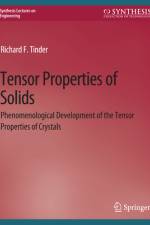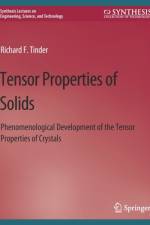von Richard Tinder
35,00 €
Tensor Properties of Solids presents the phenomenological development of solid state properties represented as matter tensors in two parts: Part I on equilibrium tensor properties and Part II on transport tensor properties. Part I begins with an introduction to tensor notation, transformations, algebra, and calculus together with the matrix representations. Crystallography, as it relates to tensor properties of crystals, completes the background treatment. A generalized treatment of solid-state equilibrium thermodynamics leads to the systematic correlation of equilibrium tensor properties. This is followed by developments covering first-, second-, third-, and higher-order tensor effects. Included are the generalized compliance and rigidity matrices for first-order tensor properties, Maxwell relations, effect of measurement conditions, and the dependent coupled effects and use of interaction diagrams. Part I concludes with the second- and higher-order effects, including numerous optical tensor properties. Part II presents the driving forces and fluxes for the well-known proper conductivities. An introduction to irreversible thermodynamics includes the concepts of microscopic reversibility, Onsager's reciprocity principle, entropy density production, and the proper choice of the transport parameters. This is followed by the force-flux equations for electronic charge and heat flow and the relationships between the proper conductivities and phenomenological coefficients. The thermoelectric effects in solids are discussed and extended to the piezothermoelectric and piezoresistance tensor effects. The subjects of thermomagnetic, galvanomagnetic, and thermogalvanomagnetic effects are developed together with other higher-order magnetotransport property tensors. A glossary of terms, expressions, and symbols are provided at the end of the text, and end-of-chapter problems are provided on request. Endnotes provide the necessary references for further reading. Table of Contents: I. Equilibrium Tensor Properties of Solids / Introduction / Introduction to Tensor Notation, Tensor Transformations, Tensor Calculus, and Matrix Representation / Crystal Systems, Symmetry Elements, and Symmetry Transformations / Generalized Thermostatics and the Systematic Correlation of Physical Properties / The Dependent Coupled Effects and the Interrelationships Between First-Order Tensor Properties - Use of Interaction Diagrams / Third- and Fourth-Rank Tensor Properties - Symmetry Considerations / Second- and Higher-Order Effects - Symmetry Considerations / II. Transport Properties of Solids / Introduction to Transport Properties and the Thermodynamics of Irreversible Processes / Thermoelectric, Piezothermoelectric, and Diffusive Effects in Solids / Effect of Magnetic Field on the Transport Properties / Appendix A: Magnetic Tensor Properties, Magnetic Crystals, and the Combined Space-Time Transformations / Endnotes / Glossary / Biography / Index



